Bjarne Melgaard and the Lustfulness of Loneliness
by Elda Oreto
“Starstruck” is the word to describe when someone is fascinated or even obsessed with a Celebrity. This is the first word that came to my mind when I got to see Bjarne Melgaard’s works for the first time. Above all, I was struck by a pure and vague sensation that mixed together a desperate need for love and acceptance with an irrepressible desire for provocation and freedom at the same time. I thought that with the passing of time both freedom and provocation would have faded away; the impetus would have been swallowed by the capitalist machine which if it does not transform us into production robots, would have for sure made us all intolerant bleeding hearts. But instead with the art of Bjarne Melgaard this did not happen, even through time it remains, like the first time, a nice strong punch in the eye. Since his early beginning in the art world, Melgaard, Norwegian artist born in Sydney in 1967, who lives and works in Oslo but for many years lived in New York, has chosen his own personal stylistic code, his own aesthetic code of behaviour, adding to the neo-expressionist pictorial gesture elements very close to the visual universe of the marginal phenomena of subcultures. All woven in a tone free from any metaphor and that is extremely critical on the paradigms, norms and hypocrisies of contemporary society.
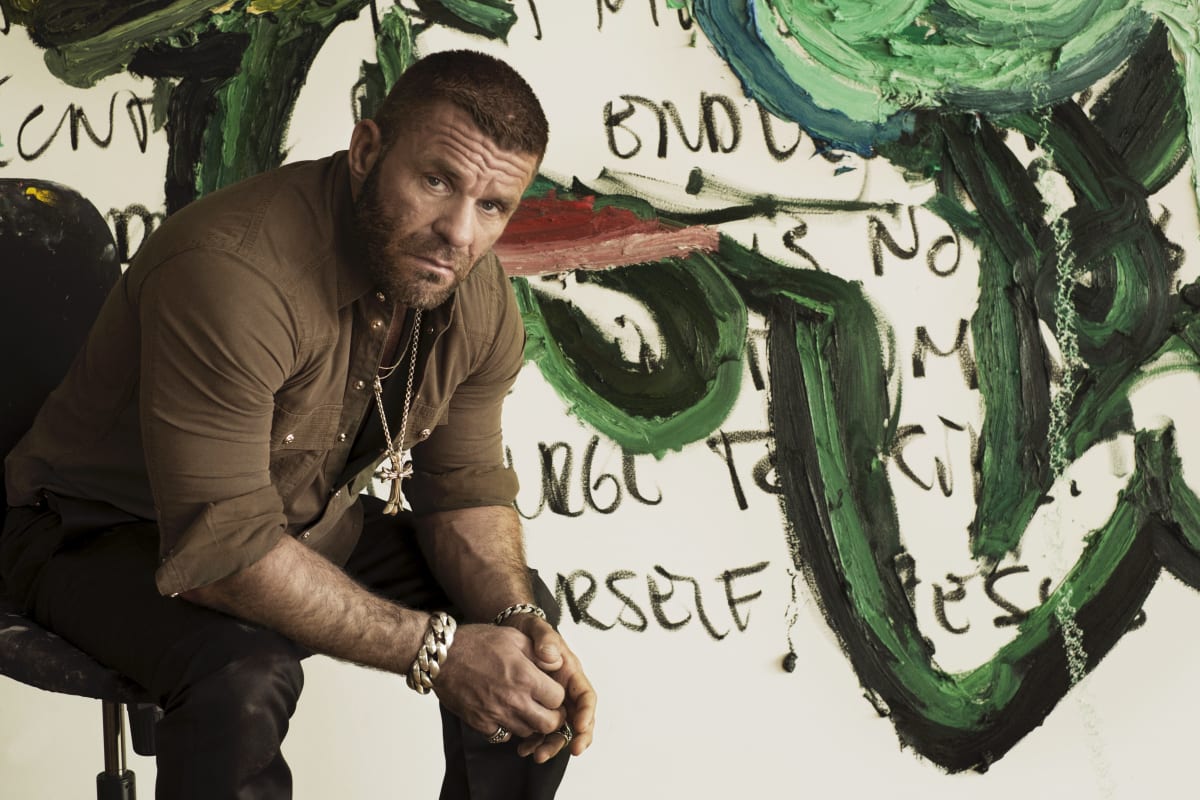
Bjarne Melgaard © 2013 Johan LindebergIn the heyday of neo-conceptualism during the mid-1990s, Bjarne Melgaard bursted into the art scene with expressionist and chaotic paintings, sculptures and installations full of fear-filled desires, mixing shamelessly fiction and reality. This peculiar attitude made him immediately famous and irresistible even if his practice has always had at heart a great poetic sensitivity, which perhaps expresses a deep loneliness. In one of his first solo exhibitions, Nothing Special, displayed in 2002 at the Galleri Faurschou in Copenhagen, Melgaard transformed the gallery space into a total installation in which the presence/absence of the artist plays a key role, where the objects stacked together become alive. In this space, which seems a chaos of products consumed and expelled by an omnivorous and gigantic body, or rather in this space, the spectator is completely absorbed. Among the artworks displayed, huge semi-transparent coloured banners, where we can see written the verse of a song “You are my sunken beach”. Together with the banners and the paintings in which emerge some characters that are recurring elements in Melgaard’s entire artistic story, there were a series of drawings, titled “Chemical Diary” and some small sculptures. All of it was pervaded in an atmosphere that merges elements of the Metal music, the homosexual S/M scene and gothic feelings.
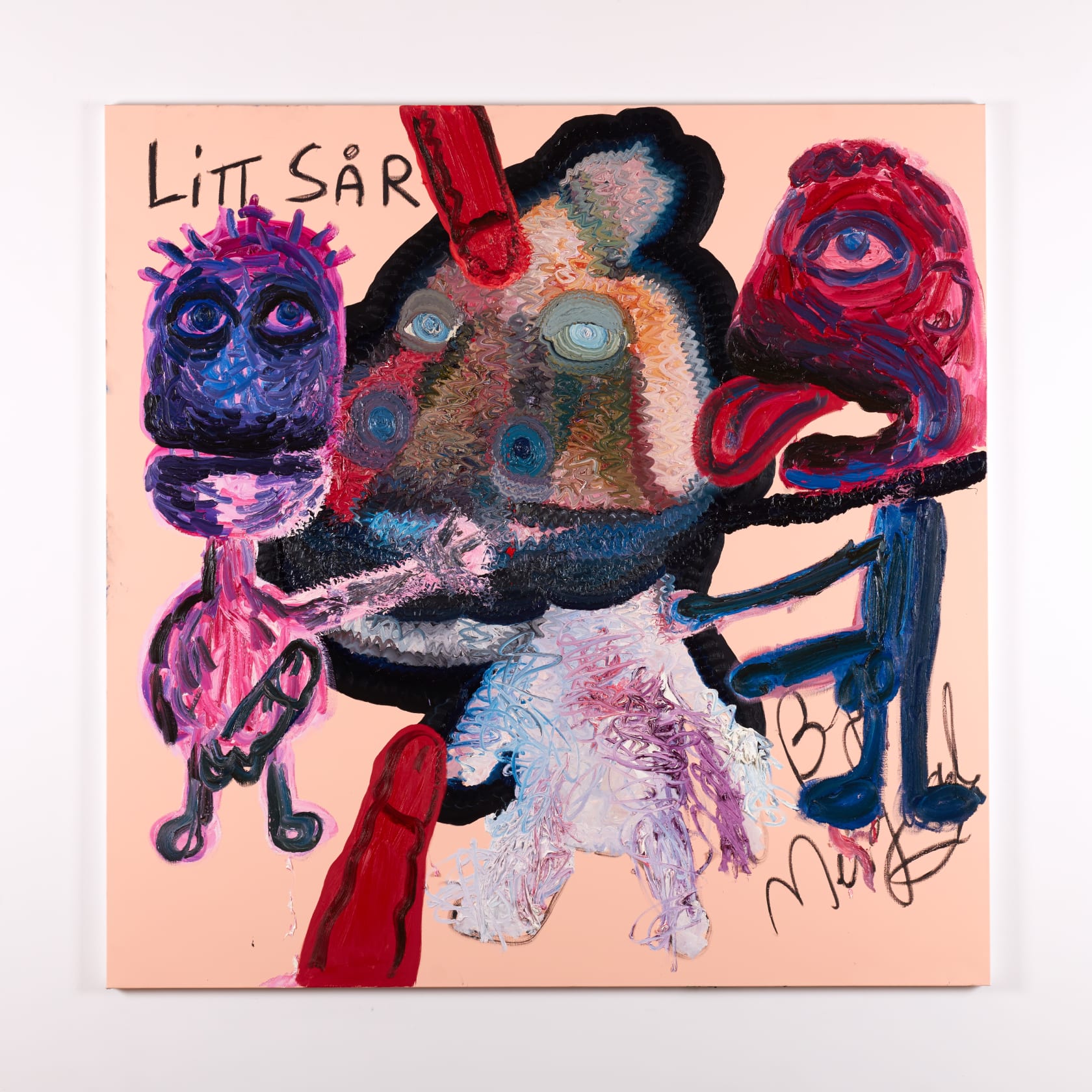
Bjarne Melgaard Untitled, 2017–18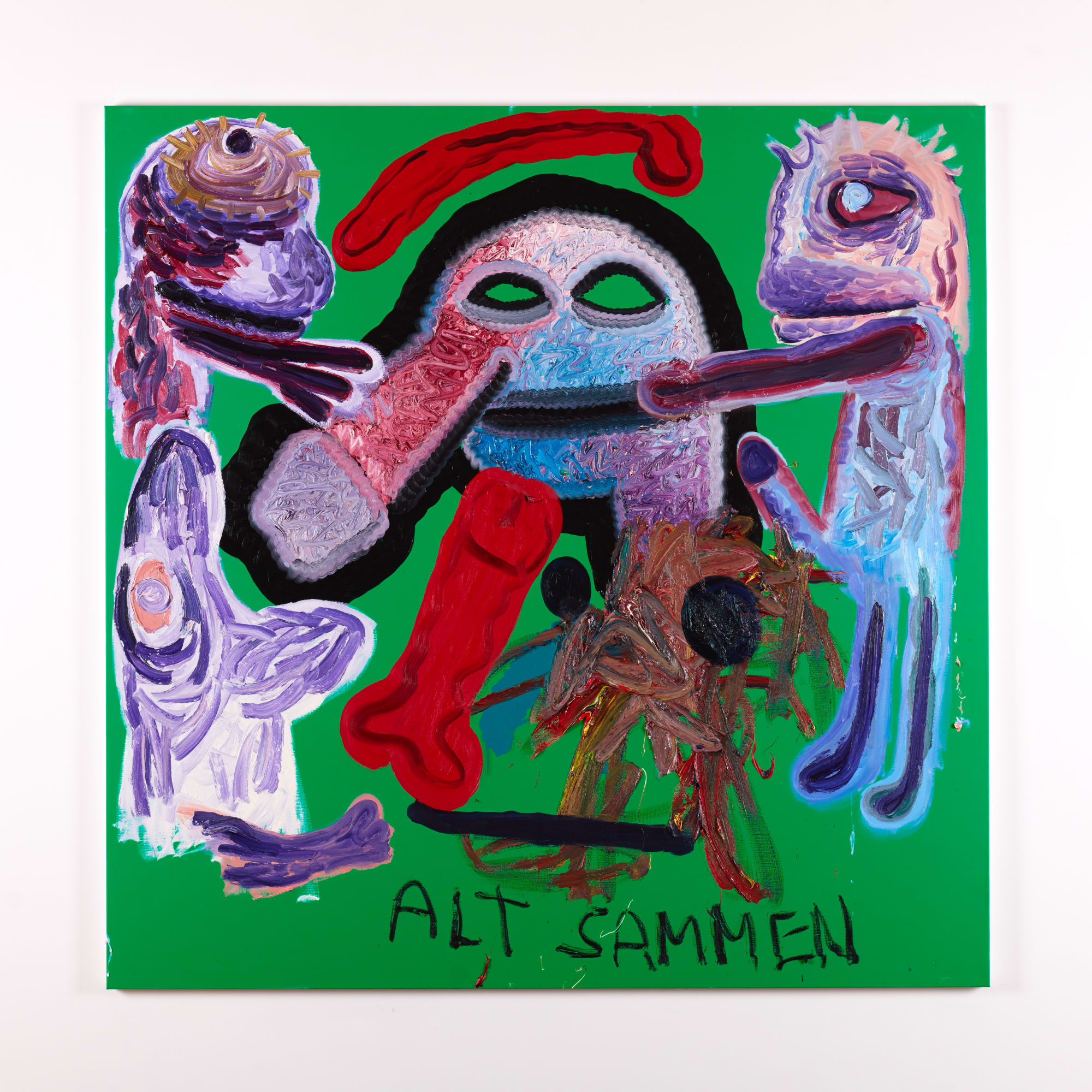
Bjarne Melgaard Untitled, 2017–18Melgaard works with any media: painting, sculpture, video, installation, writing, and recently he has also created a series of Augmented Realities and VR works for Acute Art. But there’s always a common thread that unites his narrative. Melgaard exhibits a private story with a strong introspective note that finds its coherence in the repetition of some figures, elements, which are his conceptual characters, that have emerged from the artist’s visions. These characters are hybrids half human and half animal and they find space on Melgaard’s bright coloured oil on canvases. In addition to the figures, some writings are also featured, sentences in Norwegian or English that act as a counterpoint to the images as in the paintings presented in 2007 at The Glamorous Chase exhibition at Galleri Farschou, and in the 2008 exhibition by Greene Naftali in New York. These “personal archetypes” by Melgaard reveal a profound research on his personal condition, the creativity resulting from loneliness, overcoming the solitude through an extreme “embrace of male sexuality” for a story that is both celebration and anguish. “YOU WANNA BE A WHITE MAN’S BLACK BITCH? TWO MINUTES LATER A REPLY COMES: YES; tote bags; duct tape; flat-screen TV; white, pink, and black marble sculptures; Men Without Love; Old Holland oil paint tubes; Krink inks; black Chanel Ballerines; The Synthetic Slut: New York; (…) ” is the incipit of the press release for the exhibition The Synthetic Slut: A Novel by Bjarne Melgaard, presented by Greene Naftali in New York in 2010 where the artist describes the most schizophrenic and borderline aspect of living in the artistic community and at the same time as a homosexual linked to the New York underground scene.

Bjarne Melgaard Untitled, 2015
Oil on canvas and mixed media (synthetic hair)
208 x 208 x 13 cmBy creating a total art experience, Melgaard constructs in the exhibition space a totalizing environment in which elements belonging to his personal life experience are superimposed on images belonging to mass culture. Thus the viewer does not simply identify with the story of the artist’s life by looking at the paintings on the walls but recognizes in these images his impressions and opinions on the world of art and society. It’s a game of bringing to the surface and acceptance that makes the most hidden references and obscene parts emerge. Melgaard pins his inner world to the outer reality, in the room there are self-portraits of the artist pierced by knives, sculptures reminiscent of miniatures of temples on which there’s an avalanche of colour and puppets that seem animated. Sexuality, desire, alienation and death are among the themes investigated by the artist, who transforms them into an idiosyncratic language. The use of fragmented writings and phrases, exclamations and singular words blends with the graphic element, visual with the phoneme, the small segmental unit of sound. Together, words, paintings, drawings and sculptures become a global installation, which submerges and overwhelms the viewer in his own particular time and space. “The idea is that a discourse is gonna help the fact that we are all a bunch of useless whores without a client. We think discourse is where intellect and education will somehow let us transcend the fact that we are speechless when we are met with a reality without any excuse”.

Bjarne Melgaard Untitled, 2017–18
Oil on canvas
180 x 180 cmMelgaard does not define himself as a political artist but his work is rooted in a strong identification with the queer identity of the 70s and 80s. In 2010, Jealous his first retrospective exhibition was held at the Astrup Fearnley Museum, curated by Gunnar B. Kvaran, Hanne Beate Ueland, Grete Årbu. On display there were the most important works of the last fifteen years to highlight the different periods in Melgaard’s artistic path along with some new paintings. Melgaard builds a labyrinth that from the drawings to the installations, stratifies a complex narrative in which the protagonists are excessive and destructive characters, and where strokes and sketches take the form of otherworldly phenomena, with a soundtrack of outrageous words and violence. Melgaard’s poetics are full of references to the tradition of expressionism, to Edvard Munch, the artist’s spiritual and stylistic mentor. His painting is born from an instinctive gesture in which the images are brought to life from that inhabited shortcoming that is the space where desires and demons collide. Sensations and sensuality play an important role to the point of becoming almost an abstraction. Melgaard imagines fantastic scenes, or rather, he makes dreams and fantasies “visible”, as if he was trying to make them real.

Bjarne Melgaard Untitled, 2015
Oil on canvas and mixed media (synthetic hair)
205.7 x 205.7 x 15.2 cm
Bjarne Melgaard Untitled, 2015
Synthetic hair, resin, Polaroid photographs and oil paint
233.7 x 76.2 x 109.2 cmIn 2011, Bjarne Melgaard represented Norway in the pavilion of the 54th Venice Biennale with an intervention, as usual very provocative, called Baton Sinister, in collaboration with students from “Beyond Death: Viral Discontents and Contemporary Notions about AIDS”, a postgraduate program led by him at the IUAV University of Venice in Palazzo Contarini. The exhibition included a series of works of art, events and exhibitions, all emerging from the conferences, workshops and seminars. Through this project, Melgaard questions the idea of authorship in art. This concept also emerges in the exhibition After Shelley Duvall ’72 (Frogs on the High Line), curated by Bjarne Melgaard himself at Maccarone, New York. The exhibition featured works by Anonymous Three, Omar Harvey, Fabienne Audeoud and John Russell, Michael Alig, Alissa Bennett, Sverre Bjertnes, Big Fat Black Cock, Inc., Caroline Busta, William L. Copley, John Duncan, John Kelsey, Richard Kern, Michael Bernard Loggins, Lydia Lunch, John Patrick McKenzie, Dwight Mackintosh, Bjarne Melgaard himself with one of his films, Marlon Mullen, William Pope.L, Sam Pulitzer + Mathieu Malouf, Seth Shapiro, and the Estate of Martin Wong. The idea was that a work of art would function based on the work and gestures of other artists, and that an artist’s work inevitably recalls attitudes and speculations that refer to the people you love or the artists you need. Love and need are the protagonists of a show that is based on the idea that any notion of failure is irrelevant.

Bjarne Melgaard A Damaged Man, 2020
Oil paint on canvas
60 x 50 cmA prolific and polymorphic artist, Melgaard has also written novels as well as making paintings, drawings, films, working with design, furniture and objects. The stories of his novels speak a language made of explosion of words and ideas, feverish and graphic, with vivid and even somewhat absurd descriptions of explicit sex, especially sadomasochistic. In his fictional universe, Melgaard firmly refuses to raise a border between reality and fantasy. In 2012, at Luxembourg & Dayan he inaugurated an exhibition for the publication of his firs novel published in English. The story: a tortured infatuation of the protagonist with a doorman and the degraded scene from which the surrounding characters emerge. Basically this was an exploration of the ways in which sex and violence mix together with love and loneliness and where the experience of pain pushes one into an animalistic state where abuse becomes a kind of certainty, a reliable point in an otherwise uncertain existence. The exhibition was then displayed at the 12th Lyon Biennale. The artist’s profound sense of separation and isolation are negotiated by art in a process of translation of ideas that passes from one medium to another.
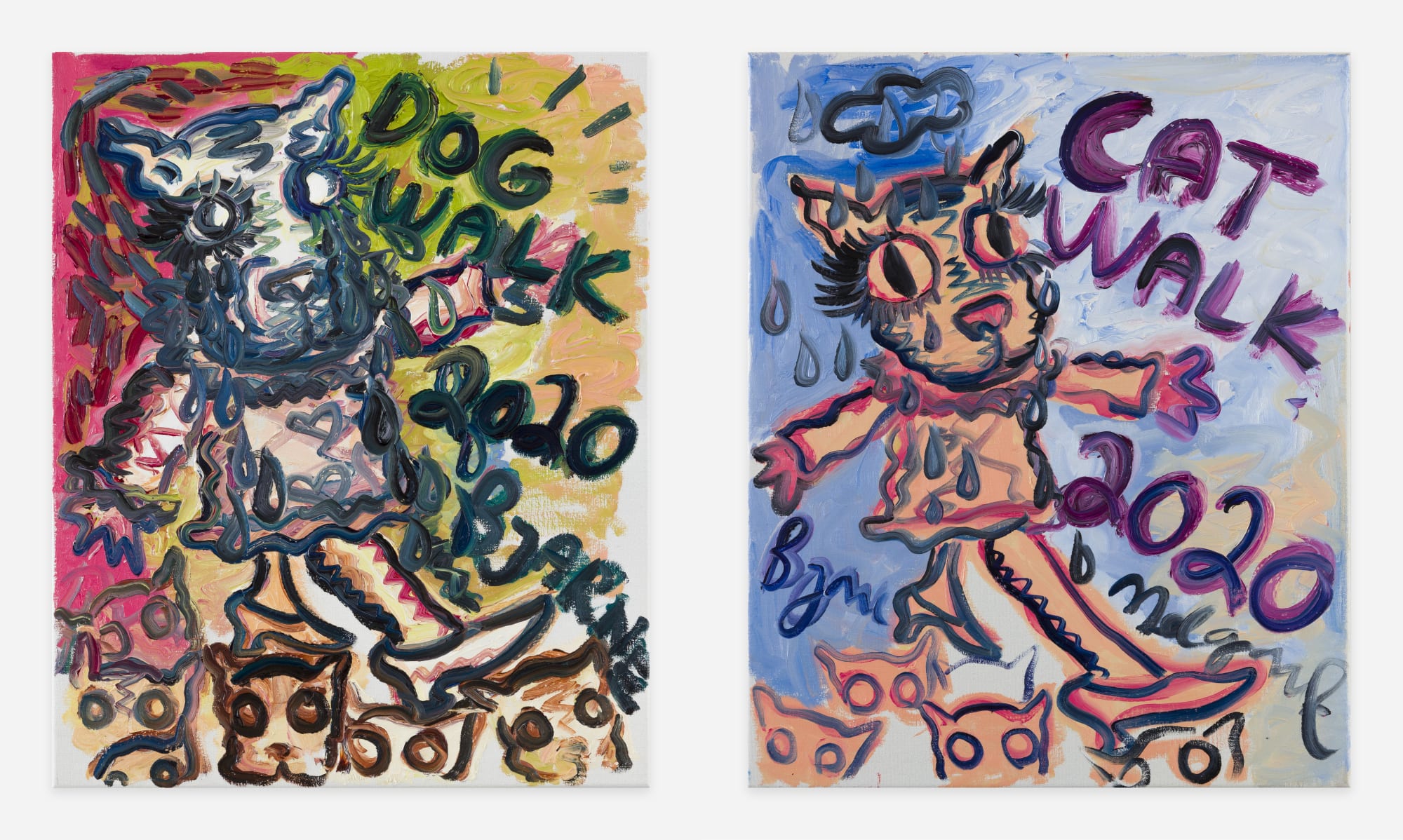
Bjarne Melgaard Cat/Dog Walk, 2020
Oil paint on canvas
Diptych, each: 60 x 50 cmAmong the films made by the artist are worth mentioning: The awakening and consumption of Heidi Fleiss as she talks to a brioche named Austin, 2013; Goodbye to Love, 2017; Pepto Abysmal, 2013; All Gym Queens Deserve to Die, 2000; Antwerp, 2012. The Ignorant Transparencies solo-show, by Gavin Brown Enterprise, in 2013 is a flow of works that goes from one sensation to another as in a demonic possession. At the entrance of the gallery there was a 12-foot-high sculpture of a super colorful crystal Pink Panther smoking a cigar. In front of it a mural that reproduces the blurry image of a woman walking towards the viewer and a white writing “sometimes you are a monster.” In the same year, at White Columns in New York, Melgaard orchestrated an exhibition of paintings by the artist Sverre Bjertnes, with whom he had shared the studio for many years. Along with the works on display there was also the furniture of dealer and artist Robert Loughlin, nicknamed “The President” by Andy Warhol, who had a strong influence in the world of Design, even though he lived most of his life in a trailer in New Jersey.
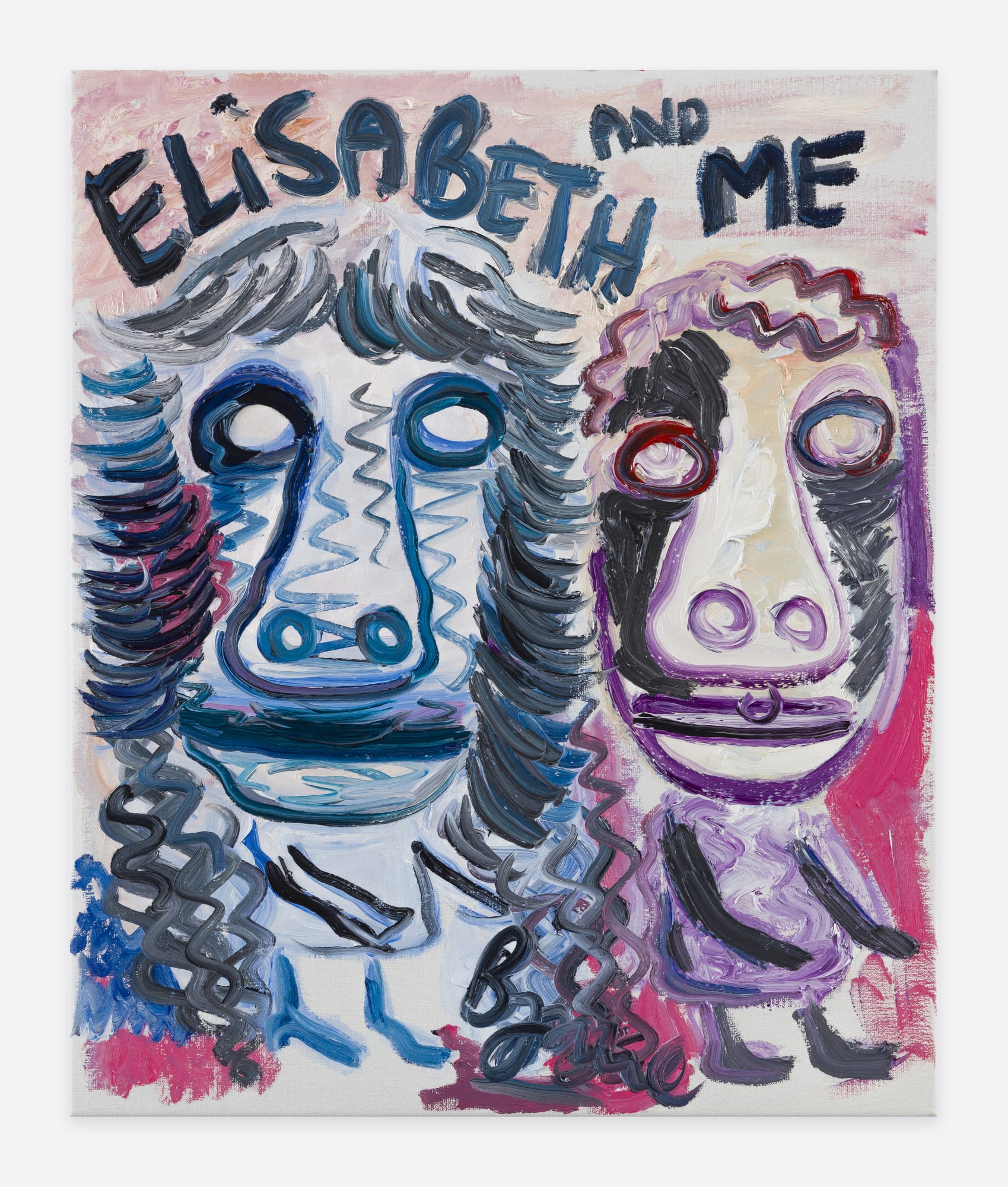
Bjarne Melgaard Elisabeth and Me, 2020
Oil paint on canvas
60 x 50 cmIn the group show Empire State, by Galerie Thaddaeus Ropac, curated by Norman Rosenthal and Alex Gartenfeld, Melgaard was presented together with some of the hottest artists of the New York scene such as Michele Abeles, Uri Aran, Darren Bader, Antoine Catala, Moyra Davey, Keith Edmier, LaToya Ruby Frazier, Dan Graham, Renée Green, Wade Guyton, Shadi Habib Allah. For this exhibition Melgaard created a series of furniture objects made of female mannequins, positioned as if they were bent to hold a seat or a glass table. It was an unprecedented scandal, I remember. Nowadays very similar works of art by young artists are considered an emblem of female emancipation. Things change quickly in the art world. The following year, at the Whitney Biennial, Melgaard focuses on the concept of the Anthropocene, a new geological age created by human activity, especially due to global warming. According to the artist, our mind has been abused and damaged just like the environment around us. Images from the “deep web” are projected on a wall, a kind of depraved internet social stream of consciousness, a nightmare made into videos of daily life, torture, genocidal attacks, mass suicide scenes, war and terrorism. Melgaard explained that the installation refers in part to a satiric and libertine tale by Claude-Prosper de Crébillon from 1742 and also to the work of the young contemporary writer Travis Jeppesen.
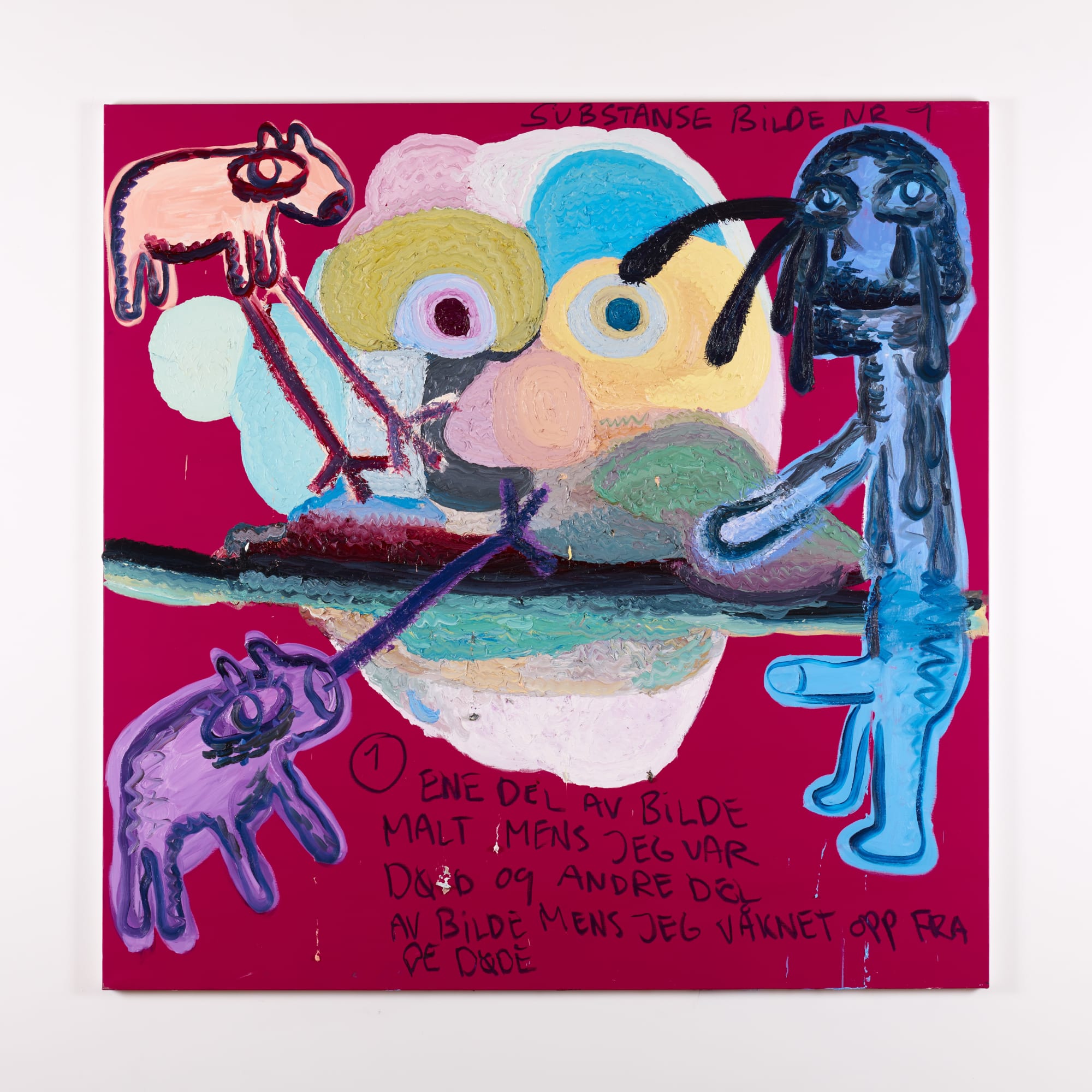
Bjarne Melgaard Untitled, 2017–18
Oil on canvas
180 x 180 cmThe exhibition “Melgaard + Munch: The End Of It All Has Already Happened”, at the Munch Museet in Oslo in 2015 explored the connection between Munch and Melgaard, reflecting on the deep connection of their work, beyond style and quotes. Melgaard, exploring wider horizons, has also collaborated with the world of fashion and design, for example in W magazine, with Red Bull Arts New York, BJØRG Fine Jewelery, the collaboration at Gavin Brown’s Enterprise and recently with NewModels.io. In Let Your Mind Be Your Bed, at New York’s Performance Space in 2018, he staged a Puppets show. And shortly after, in 2019, he began a collaboration with Acute Art to create a virtual reality presented at the Julia Stoschek Collection and subsequently to bring his archetypal characters to life in the form of Augmented Realities. In the end, Melgaard could use any type of media in order to reach the public and to tell a private story in a constellation of characters that enrich his solitude. For the “Elisabeth and Me” exhibition at Galerie Thaddaeus Ropac, Paris Marais, in 2020 Melgard was inspired by the life and work of Elizabeth Wurtzel (1967-2020), the author of the cult Prozac Nation. In these new paintings Melgaard reflects on the psychological and social consequences of the current pandemic, such as depression and prolonged isolation. The small paintings are installed on a specially designed psychedelic wallpaper full of references to Elizabeth Wurtzel’s life and writings. Melgaard has never met Elizabeth Wurtzel but felt close to her discomfort. Recently, he discovered that not only did they both have common roots in the Nordic culture, but they also had the same psychotherapist. Wurtzel’s provocative behaviour finds an echo in Melgaard’s paintings, which presents her gestures as subversive and intuitive in bright colours with thick impasto that is condensed and left to dry.
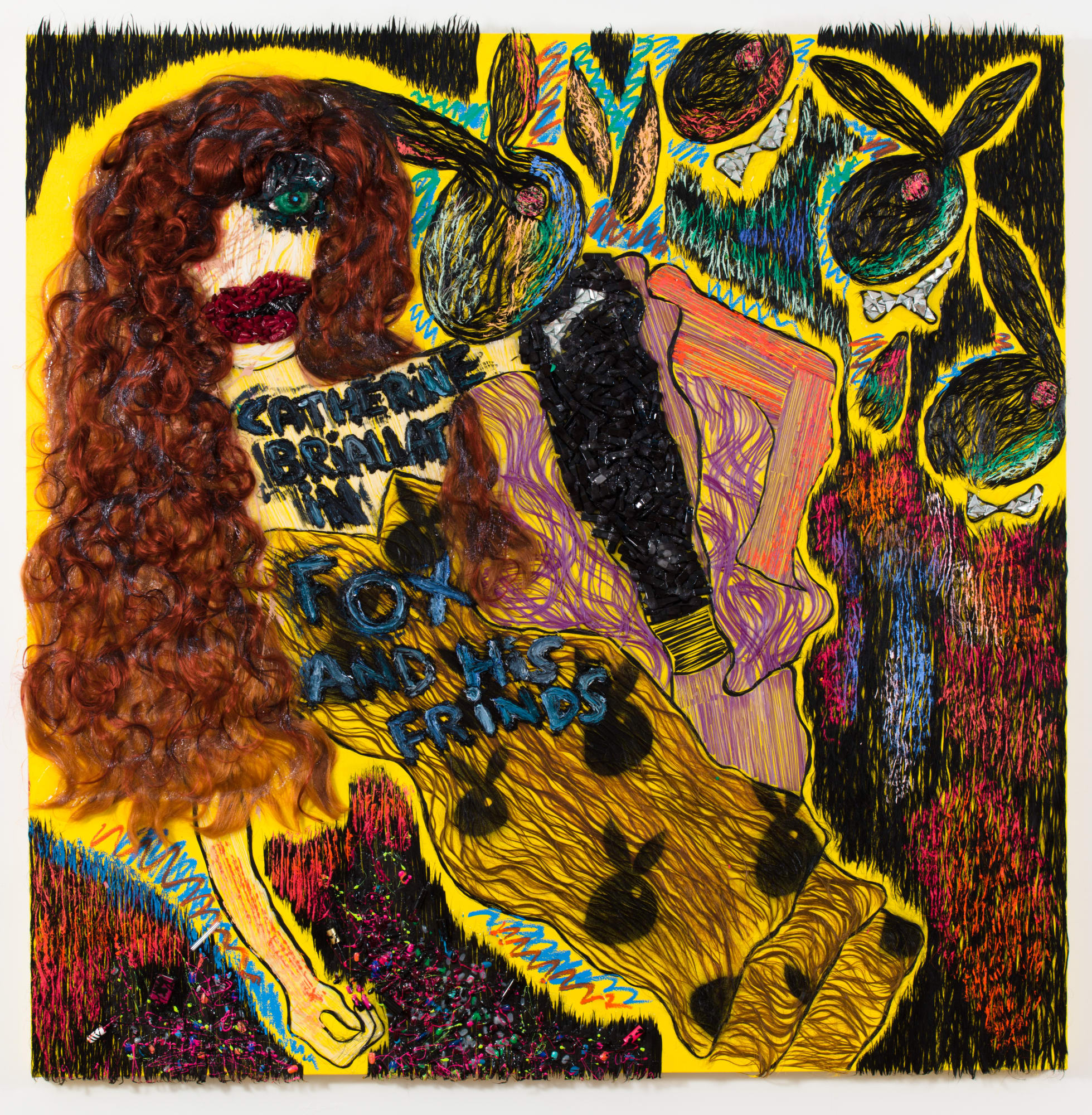
Bjarne Melgaard Untitled, 2015
Oil on canvas and mixed media (synthetic hair and eye lashes, resin, makeup products)
208 x 208 x 13 cmMelgaard’s quick brushstrokes indicate the search for limitless expression that captures the emotion of the moment. The wavy zigzag lines convey an energy that also suggests the effect of drugs, alluding to Wurtzel’s story of a depressed and drug-addicted generation. Melgaard’s art pieces echo the idea that each of us has become the star of his own drama, without any possibility of authentically communicating to each other. We are alone, each locked up in his own private hell.

